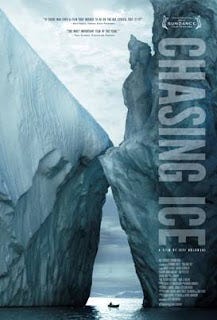Doc Review: Chasing Ice

National Geographic photographer James Balog feels that climate change is the defining issue of our time. He says that every era has its illusions and the illusion now is that climate change is not real or not a real threat to our planet. In Balog's view, nothing anyone is doing right now matters as much as solving the climate problem. He believes we are approaching a sixth extinction, caused by the first world, but largely impacting the third world. Many species will die out. There will be large scale global flooding, which will cost the first world trillions. In other words, our grandkids will need their Ipads to be waterproof. Future app designers should create an app for remembering animals of the 20th century, and perhaps one that automatically transmits spiteful messages to their grandparents for destroying the planet.
Finding and showing the evidence of climate change is Balog's life mission. Before Chasing Ice, nobody was able to tell the story of climate change in such a powerful visual way. Al Gore used charts in his film which we all know now has very little effect on people who despise charts. Balog realized the key to telling the story of climate change is to tell it as simply and visually as possible. The story, he discovered, was in the ice. So Balog founded an organization called the Extreme Ice Survey, hired a team of young, brave assistants, and together they set up time lapse cameras trained on glaciers all over the world.
Balog's determination is awe inspiring. He battles sub-arctic weather conditions, technical problems, and a bum knee to climb up to impossible perches that yielded the best possible views of the ice. What he and filmmaker Jeff Orlowski show us is absolute proof of climate change in the form of some of the most beautiful shots of the natural world that I've ever seen. On the big screen at the Temple theater in Sundance, I was treated to hues of blues and greens that made Park City seem like a black and white world. The time lapse videos showed years of ice melting compressed into seconds. I saw gigantic glaciers disappearing before my eyes. Finally, and most epically, audiences sat mezmerized as we watched the largest ever recorded ice calving event. Balog's crew had to wait nearly 3 weeks to capture a glacier larger than Manhattan breaking off into the sea. At that moment, the documentary morphs into a kind of natural horror film. We hear a creepy cacophony of cracking noises until the ocean digests the ice block in one thunderous gulp.
If you're still doubting that climate change is real, make sure you see this film. To see a prehistoric glacier ice receding faster than a man's hairline in a Rogaine commercial is scary. National Geographic channel just bought the TV rights, so try and catch it on the small screen. I hope it gets a theatrical run, since watching glaciers the size of cities fall into the sea is definitely big screen material.
Check out these stills from the film:




